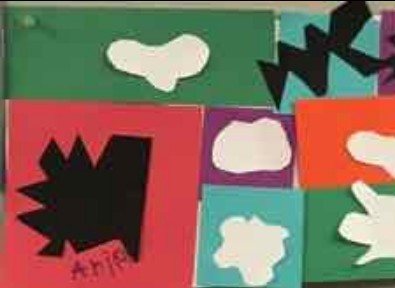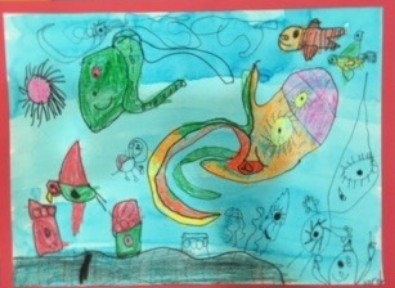First Grade Art Kits - Descriptions
9 months ago
Alaska's Bear Dreams
Alaska's Bear Dreams
After sharing a book about Alaska's
bears, students explore the topic of hibernation. They create a drawing
of a hibernating bear, complete with cut paper shapes representing the
bear’s dreams.

Clay Trays
Clay Trays
Children explore the possibilites of textures and patterns in clay using macaroni (provided in kit) and learn clay techniques to successfully create and glaze a small tray to keep or give as a gift.

Color Connections
Color Connections
Students get valuable color mixing practice in a well organized structure using hexagon papers (provided in kit) to sample their newly created colors. They work together in small groups to puzzle these hexagons together and match the colors of nature.

Do You See What I See?
Do You See What I See?
In this art lesson, students look at an abstract (“mystery”) painting done by another child and look for ideas, patterns and pictures in it. They draw their idea so we can see what they “see” in the painting, then make another abstract painting to “pass it on” to students in another class, creating a sense of community.

Draw What You See: Observational Drawing
Draw What You See: Observational Drawing
Students are guided through an introductory lesson to learn the skill of “drawing from observation.” They begin a drawing folder which can be used as a motivational and organizational tool for continuing this drawing practice throughout the year.

Drawing from Observation: Illumination
Drawing from Observation: Illumination
Students build awareness around how light illuminates objects and creates shadows by having peer conversations about art images with light/shadow and by drawing a scene using a flashlight inside a paper bag. All materials needed are included in the kit.
-jnmjph.jpg)
Drawing from Observation: Tree Seedlings
Drawing from Observation: Tree Seedlings
Students carefully observe and drawi tiny trees to build their awareness of how a seedling may differ from an adult tree. The size and amount of detail on these tiny trees is perfect for developing young students drawing abilities.
-3khk5u.jpg)
Drawing People: Constructive Drawing
Drawing People: Constructive Drawing
In this lesson students learn a technique, called constructive drawing used by cartoon artists for drawing simple people from memory or imagination. They can use this skill for illustrating stories and ideas all year long! They add written comments in speech bubbles.
-mfylyk.jpg)
Drawing with Scissors
Drawing with Scissors
Students hear a story about the famous French artist, Henri Matisse, and are inspired to create paper cut-outs of their own. This lesson teaches scissor cutting technique, works on art concepts of space, size, color and contrast and shape. Students enjoy making abstract art and “seeing” things in their art using their imagination.

Faith Ringgold Story Quilts
Faith Ringgold Story Quilts
Students learn about Faith Ringgold and consider that art often tells a story. Students explore colored pencils and draw a family memory. In the style of Faith Ringgold, these drawings are surrounded by a border of fabric squares (pre-cut fabric squares included in the kit.)

Family Portraits
Family Portraits
Students draw their family members with markers, emphasizing size comparisons and details to distinguish different members. They draw a background on colored paper, then they cut out their drawings and glue them on the background.

Fish Print Mosaics
Fish Print Mosaics
Rubber fish made from real local fish are included in this kit. As students paint and make prints on small pieces of paper, they study the parts of three local species: salmon, rockfish and flounder, looking for similarities and differences.

A House for Me, A Community for Us
A House for Me, A Community for Us
Students build a simple block house (blocks included in kit), draw a picture of their construction, and make this house their own by adding people and pets. The drawing is colored with primary colored oil pastels, encouraging color mixing. Students glue their houses into a class neighborhood and embellish this mural with additional trees, swing sets, etc.

Leaf Printing
Leaf Printing
Students learn techniques to successfully print leaves with tempera paint on small fabric banners that can then decorate the room. Using leaves the students themselves have collected makes this lesson even more meaningful. Close observation and the ability to use expanded vocabulary to describe leaves is enhanced by the process of printing.

Light and Shadow Puppet Play
Light and Shadow Puppet Play
Students create shadow puppets from pre-cut shapes using both black paper and transparent colored plastic. While making the puppets they use flashlights to test and revise their puppets to get the shadow they want. They learn beginning skills for shadow puppet performances.
-2vyd29.jpg)
Little Brown Bat
Little Brown Bat
Students create art that helps them learn about bat anatomy and behavior. They draw from observation, use primary colors to mix the color brown, paint the bat, and hear a Northwest Coast Native story about the "first mosquito." The finished student artwork includes a Northwest Coast "formline" mosquito design.

Mondrian Trees
Mondrian Trees
Students learn about Piet Mondrian who painted trees all his life using different styles. They then draw and paint a tree in the style of Piet Mondrian.

Paper Portraits
Paper Portraits
Students create a paper self portrait, practicing the paper sculpting techniques of folding, cutting and curling. They consider the concepts of “dark and light” shades of color and “big” and “small” sizes. Debra Frasier's book helps them reflect on their birth and students are asked to share where they were born, an important piece of their identity.

Patterns All a-Round
Patterns All a-Round
Students learn to print small lines and circles, using common objects. Students create a unique pattern, starting from the center of their paper and radiating out. Students observe photos of this kind of patterning evident in the world around them, and give their art a creative name.

A Penguin Story
A Penguin Story
Students create a cut paper collage of an Adelie penguin in an Antarctic habitat. This art project experiments with teh power of color, and also with overlapping shpaes to create perspective. Studnets consider the habitat needs of real penguins and the work of scientists who study them. A wonderful story provides inspiration and opportunities for writing.

Printing our Feelings
Printing our Feelings
Students learn to draw faces showing different emotions. They draw and print several faces using a "gelli" printing plate. A small book is created by each student and students complete the book by writing a simple statement for each face: "I feel _____when_____."

Under the Sea
Under the Sea
Students are guided through a fantasy under the sea adventure as imaginary scubadivers
Students communicate their ideas first in pictures then in words. They are encouraged to be descriptive, by giving their drawings patterns and details. They add colors with crayon to the areas they want to “light up,” then paint with a watercolor wash of blue. Imaginative drawing helps a child to invent a great story.

Up in the Air
Up in the Air
Students are guided through a fantasy hot air balloon adventure and create original drawings that are exceptionally detailed and interesting. Adding a small amount of one color draws the viewers attention to certain areas of the picture. Students are highly motivated to write or dictate a story about their picture.

Water Rhythms
Water Rhythms
Students begin the lesson by enjoying the story and CD “River Song” by Steve Van Zandt. Moving water makes rhythms! Inspired by water sounds and music, students paint with tempera cakes, then, using these paintings, create a cut paper collage that uses repetition to show rhythm.

Weather and Dramatic Earth Events (drama)
Weather and Dramatic Earth Events (drama)
Explore types of weather and dramatic earth events while introducing the basics of acting through guided dramatic role-play. This lesson can be used independently or to compliment a larger unit about weather, making weather observations, learning about how weather affects us, or practicing safe choices in an emergency. The kit provides opportunities for students to construct knowledge through movement, sound and imaginative play.

Wind Art
Wind Art
Students learn about Japanese artist and sculptor, Susumu Shingu, and his sculptures that move in the wind. After viewing a brief dvd, students build their own sculpture that moves in the wind. Students exercise art knowledge of shape and color. They explore the science concepts of wind and it's affects as they test and adjust their sculptures.

Word Quilt
Word Quilt
Students learn about Faith Ringgold’s love of quilting. They create a paper word quilt depicting a theme, such as “Things we Like at School,” or “Our Class Beach Trip,” etc. Students learn painting techniques, make a detailed painting and write a word to describe it. The display of finished artwork creates a “quilt” of geometric shapes and a word bank.
